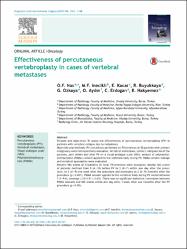Effectiveness of percutaneous vertebroplasty in cases of vertebral metastases

Göster/
Erişim
info:eu-repo/semantics/openAccessTarih
2015Yazar
Nas, Ömer Fatihİnecikli, Mehmet Fatih
Kaçar, Emre
Büyükkaya, Ramazan
Özkaya, Güven
Aydın, Ömer
Erdoğan, Cüneyt
Hakyemez, Bahattin
Üst veri
Tüm öğe kaydını gösterKünye
Nas, O.F., Inecikli, M.F., Kacar, E., Buyukkaya, R:, Ozkaya, G., Aydin, O., Erdogan, C. ve diğerleri (2015). Effectiveness of percutaneous vertebroplasty in cases of vertebral metastases. Diagnostic and Interventional Imaging, 96(11), 1161-1168.Özet
Purpose and objectives: To assess the effectiveness of percutaneous vertebroplasty (PV) in patients with vertebral collapse due to metastases. Materials and methods: PV procedures performed on 95 vertebras in 52 patients with primary malignancy were retrospectively evaluated. Vertebral metastases, primary malignancies of the patients, pain before and after PV on a visual analogue scale (VAS), amount of polymethylmethacrylate (PMMA) cement applied to the vertebral body during PV, PMMA cement leakage and vertebral approaches were evaluated. Results: VAS scores of 43 patients (in total 79 vertebras) were evaluated. Median VAS scores of patients declined from 8 (4-10) before PV to 3 (0-7) within one day after the procedure, to 2 (0-9) one week after the procedure and eventually to 2 (0-9) 3 months after the procedure (p < 0.001). PMMA amount applied to the vertebral body during PV varied between 1.5-9 mL (average +/- SD 4.91 +/- 1.61). There was no significant statistical correlation between PMMA amounts and VAS scores within one day after, 1 week after and 3 months after the PV procedure (p > 0.05). Conclusion: PV is a simple, effective, reliable, easy to perform and minimally invasive procedure in patients with painful vertebral metastases. (C) 2015 Editions francaises de radiologie. Published by Elsevier Masson SAS. All rights reserved.

















